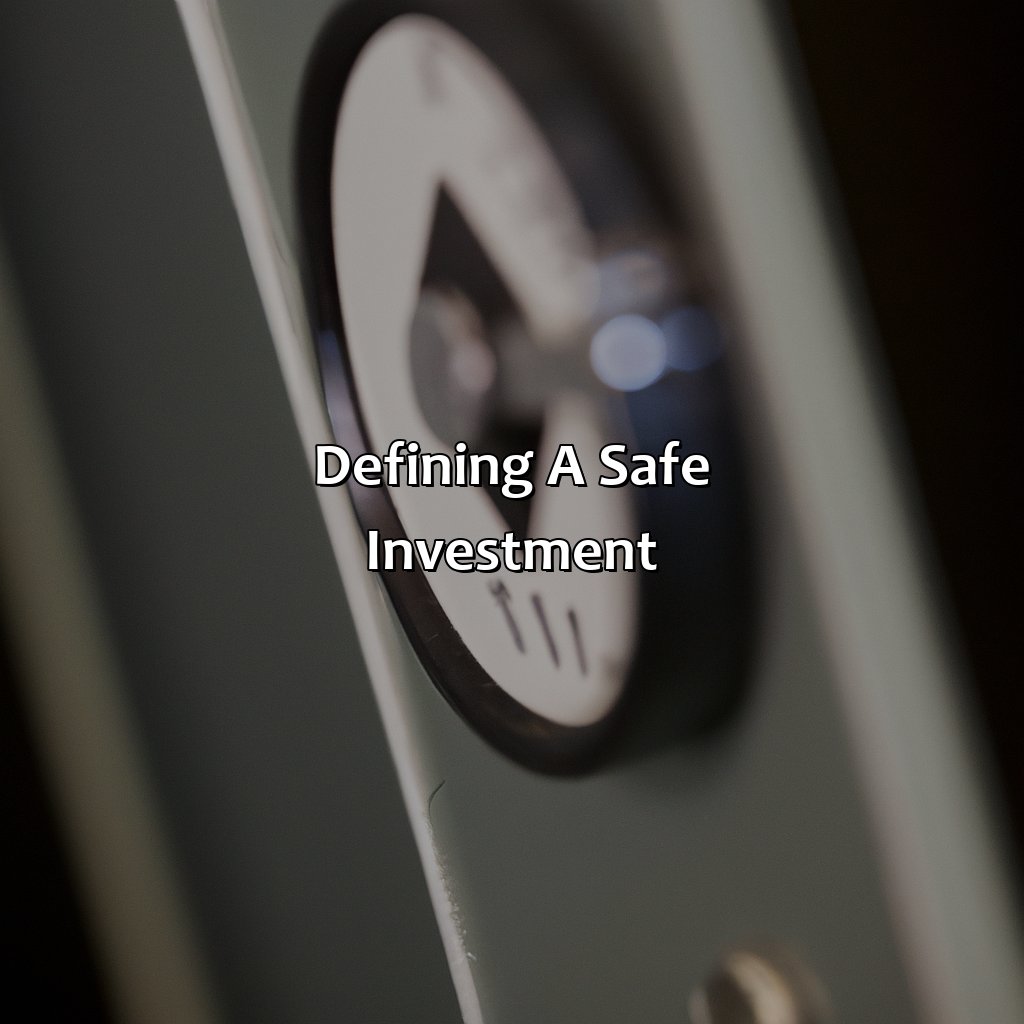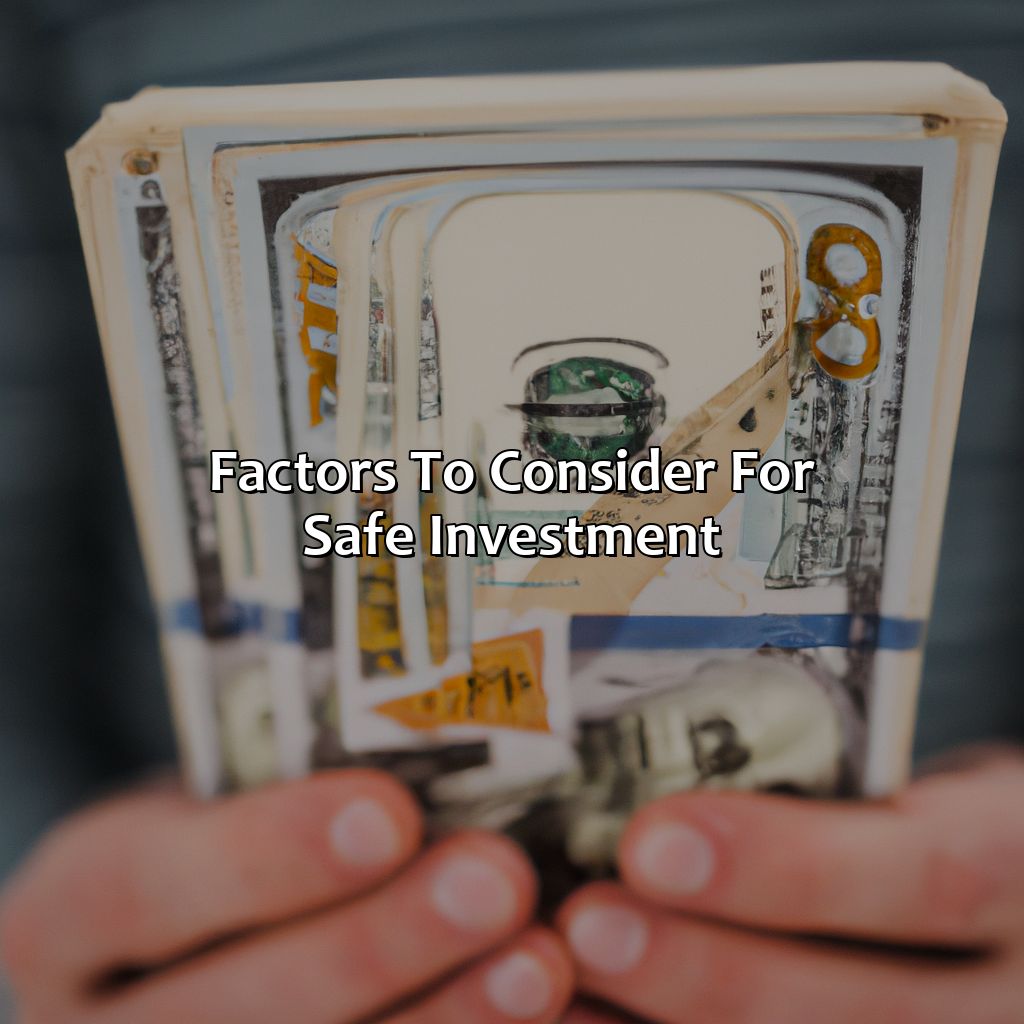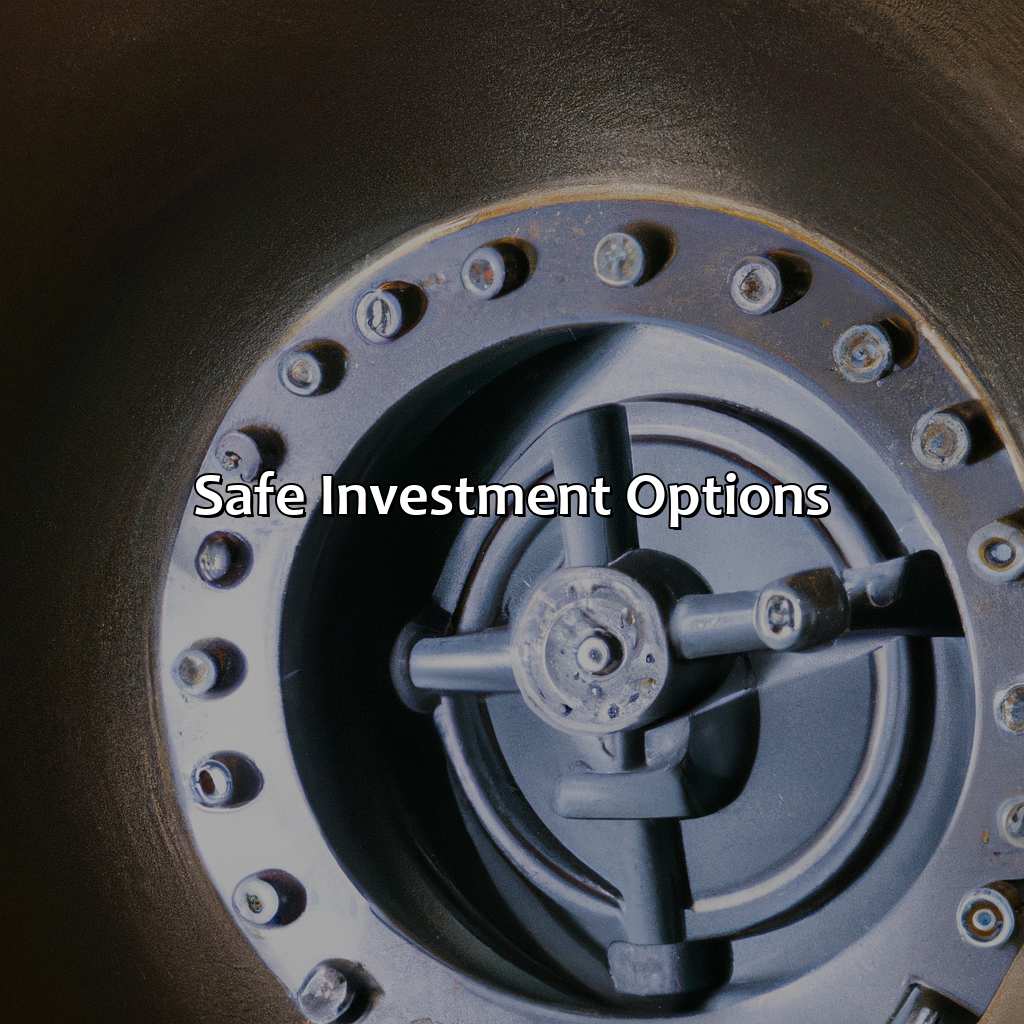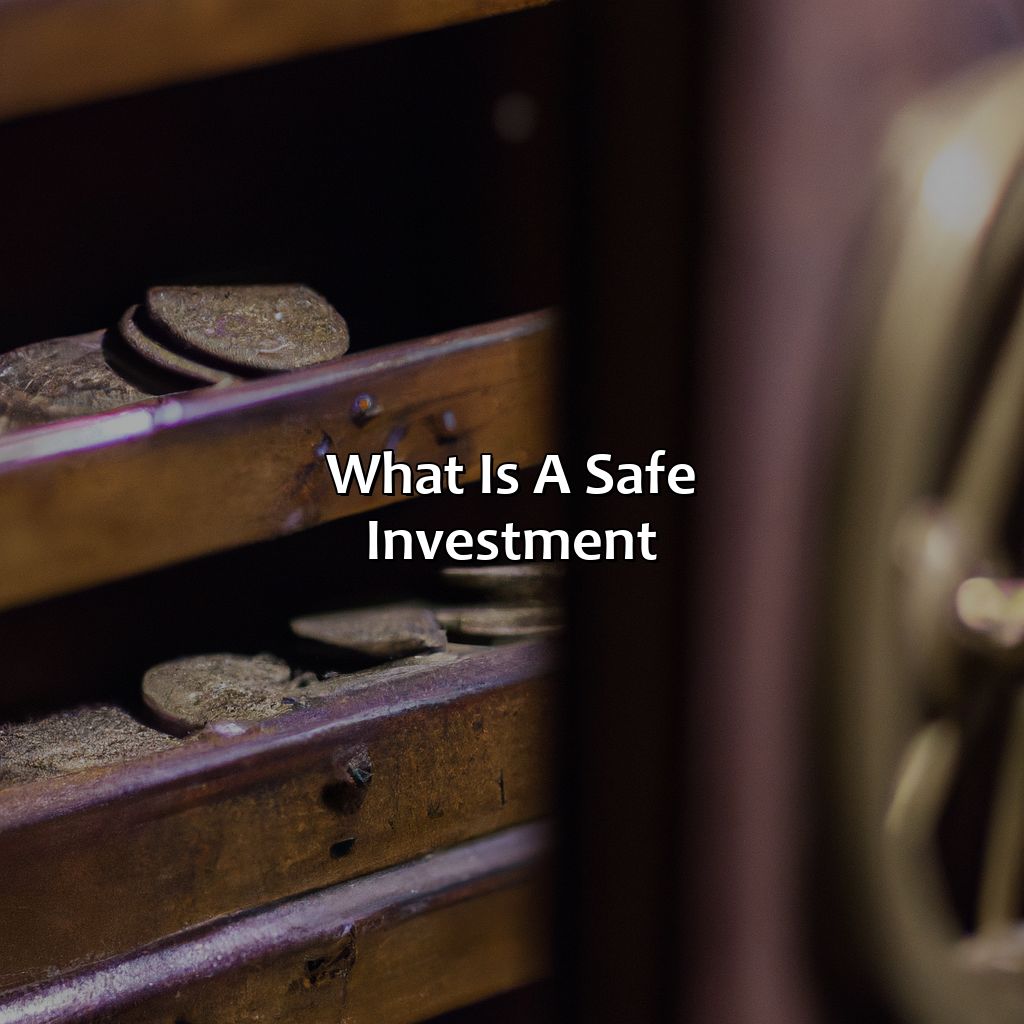What Is A Safe Investment?
Key Takeaway:
- A safe investment is one that provides a low level of risk and a reasonable rate of return. It is important to understand the various options available and consider factors such as market volatility, investment duration, and diversification when determining the safest investment option.
- Market volatility can have a significant impact on the value of investments. It is important to invest in options with a strong track record for stability, such as savings accounts, CDs, treasury bonds, and annuities.
- Investment duration is also a key consideration when choosing a safe investment option. Those looking for short-term investments should consider savings accounts and CDs, while those with a longer investment horizon may want to consider treasury bonds or annuities.
Are you concerned about where and how to invest your money safely? This article provides valuable insights to understand what a safe investment is and how to make one. You don’t have to worry about your hard-earned cash – let’s find out how to invest wisely.
Defining a Safe Investment
Many investors are often cautious about investing their money in financial markets. They want to select investments that are safe, providing a secure and guaranteed return on investment. So, what exactly is a secure investment? A secure investment is such that the principal investment remains secure, and the investor gets a guaranteed return. Diversifying investments between stocks, bonds, and cash may provide a balance of risk versus security.
To protect their money, many investors look for safe options like government bonds, personal savings accounts, or certificates of deposit. However, these options can offer low returns and may not offer the best ways to grow their wealth. A good way to balance risk is to diversify their investments. In combining different investments, investors can minimize the risk of losing their money while maximizing their potential to earn returns.
Investors also have to consider other factors such as the reputation of the investment manager and the quality of their track record. They need to do due diligence on potential investments and avoid the temptation of get-rich-quick schemes that offer quick returns but carry high risk.
Remember, investing always comes with risks. No investment is entirely risk-free, and different investments carry varying levels of risk and reward. Thus, the best strategy for investors is to seek return with minimal risk, and to do so with a long-term focus. Don’t let fear of missing out drive investment decisions; instead, consider seeking professional financial advice to create an investment strategy that suits individual needs and risk tolerance.

Image credits: retiregenz.com by James Duncun
Factors to Consider for Safe Investment
Focus on markets with low volatility to make a secure investment. Think about how long it’ll last and diversify your efforts. These bits of info will give you the know-how to get better returns. Read on and learn more about these sub-sections.

Image credits: retiregenz.com by David Washington
Market Volatility
Investors often face uncertainty and risks in the market. The unpredictability of price swings is known as Investment Volatility. This condition often causes investors to feel uneasy about their portfolio’s overall value.
Investment volatility can result from many factors, such as economic slowdowns, geopolitical tensions, or natural disasters. Market forces create these events that inevitably cause sudden changes in stock prices.
To mitigate the negative effects of investment volatility, diversification is crucial. It implies investing in multiple assets classes that are unrelated to one another to spread risk. Bonds and real estate are excellent alternatives for those seeking stability during high market volatility circumstances.
It is vital to stay mindful of your financial goals when dealing with investment volatilities experienced over a span of hours, days, or months. History has shown that the market always adjusts itself with time.
Pro Tip: In high-volatility situations, avoid reacting emotionally by impulsively buying or selling assets. Instead, develop an investment plan that accommodates both expected and unexpected changes in market conditions long-term.
Remember, investing is a marathon not a sprint, unless of course you’re investing in a gym membership.
Investment Duration
Investment duration plays a crucial role in ensuring the safety of an investment. The period for which the investment is expected to be held affects the choice of investment options and overall returns.
Short-term investments are typically those that mature within a year or less while long-term investments extend beyond a year. Short-term investments are ideal for investors who prefer liquidity as they can easily access their funds, unlike long-term investments that can tie up funds for several years.
When considering investment duration, it’s important to evaluate personal financial goals and risk tolerance to choose appropriate investment options. Investors with low-risk tolerance may opt for short-term investments like fixed deposits while high-risk tolerance investors may prefer long-term options such as stocks.
Another factor to consider when selecting an investment duration is taxation implications; longer durations may attract higher tax rates than shorter ones, impacting overall returns.
Historically, long-term investors have experienced strong returns over time through compound interest; Warren Buffet being a prime example of long term investment strategies leading to great success.
Putting all your eggs in one basket may be daring, but diversified investments are the true superheroes of the finance world.
Diversification
Investment Diversification
A wise investment strategy is not keeping all investments in one place, as it exposes an investor to a high risk of losing their money. Investment diversification or spreading the risk across a range of asset classes helps in balancing risk and reward.
Rather than investing significant funds in only one investment instrument -such as stocks, bonds, or real estate-, investors should consider investing in different industries, sectors, and asset classes simultaneously. By spreading the investment over different assets, a single economic event’s negative impact can be reduced.
Expert advice suggests investing no more than 5% of an investor’s total assets within any particular sector. For instance, instead of buying regular stocks, multiple ETFs tracking different sectors can be purchased for better diversification.
Diversifying your investments allows you to profit from capital gains and lesser losses if there is any failure in a specific security type. As markets vary with volatility at times, maintaining a diversified portfolio provides financial stability.
For example, during COVID-19 lockdowns shares of digital companies rose exponentially while brick-and-mortar businesses struggled. In this situation, diversified portfolios that were constructed beforehand mostly came out unscathed.
Investment diversification has always been a go-to strategy for investors aiming for long-term sustainable growth with lower risks compared to plain vanilla investments by highlighting the importance of balance between risks and rewards.
Want a surefire safe investment option? Stuff your money under your mattress and hope for the best.
Safe Investment Options
To find safe investments, you must start by looking at different options. To make wise choices, it is important to know the advantages of each. This section will talk about four secure investments:
- Savings accounts
- Certificates of deposit (CDs)
- Treasury bonds
- Annuities

Image credits: retiregenz.com by Adam Arnold
Savings Account
A popular financial instrument often preferred by those seeking low-risk investment options is a savings plan. This account allows an individual to deposit money at regular intervals and earn interest on the amount. As compared to other investments, the savings plan generally offers lower returns but assures minimal risk of loss. However, the interest rates are subject to change based on market fluctuations.
To open a savings account, customers need to comply with specific requirements such as minimum balance maintenance, age limit criteria, account fees and more. The interest rate provided may vary depending on these conditions.
One unique detail about savings accounts is that they may come with some restrictions on withdrawing funds for a certain period or set number of transactions in a month without charges. It is important to read through the terms and conditions before opening an account.
In the past, several banks have launched innovative schemes such as offering higher interest rates or prizes for saving regularly under savings plans. For instance, in 2019, State Bank of India had introduced Repo-linked home loans with lower interest rates aimed at increasing transparency and faster transmission of monetary policy benefits to consumers.
CDs: the perfect investment for those who want to lock away their money and their feelings.
Certificates of Deposit (CDs)
Certificate of Deposit (CDs) are a secure investment that offer a guaranteed return at the end of a specified term.
- CDs are low-risk investments that offer higher interest rates than traditional savings accounts.
- They require a minimum deposit and have fixed terms ranging from 3 months to 5 years.
- Early withdrawals may result in penalties, but some CDs offer flexible withdrawal options.
It’s worth noting that CDs aren’t as liquid as other investments, so it’s essential to lock your money in for the agreed period.
A Pro Tip when considering CDs is to shop around for competitive interest rates and keep an eye on renewals to avoid missed opportunities.
Treasury bonds are like the dull cousin at family gatherings- safe, reliable, but not exactly a conversation starter.
Treasury Bonds
Government-backed debt securities that offer a fixed interest rate are known as Treasury Bonds. These bonds guarantee repayment of the principal investment amount, and the returns may vary based on the maturity period. Treasury Bonds are considered low-risk investments due to their government backing and steady returns.
As an investor, choosing to invest in Treasury Bonds can add a secure element to your portfolio. They have different maturity periods ranging from 1 month to 30 years, which allow investors the option to choose a suitable one for their investment goals. Their liquidity is also higher than other safe investments like bank savings accounts.
It’s important to note that Treasury Bonds’ returns are sensitive to changes in interest rates; when rates rise, bond prices decrease, causing yields to rise. Additionally, taxes may impact the overall gain from these bonds.
Consider investing in Intermediate-Term Treasury Bonds for short-term goals or Long-Term Treasury Bonds for longer-term investment objectives. Another good option would be Inflation-Protected Securities because they protect against price increases.
Annuities: because who needs to enjoy their retirement when you can just give your money to an insurance company instead?
Annuities
An investment option that guarantees a steady income stream is known as a Fixed Income Stream. Annuities have become a popular choice for investors seeking predictable payouts over an extended period. A contract is made between the investor and an insurer, under which the investor provides specific payment in exchange for an income. The payouts can be deferred, scheduled or immediately paid out to the annuity holder.
One of the significant benefits of annuities is that they provide a steady income stream regardless of market conditions making them suitable for risk-averse investors. Annuity products further offer tax-deferred growth potential when held in qualified retirement accounts. Guaranteed minimum interest rate options allow investors to profit from market gains while protecting their initial investment when markets decline.
In addition to traditional fixed-rate annuities, there are also variable and indexed options available. While providing higher returns than standard fixed rates of annuities, they also have greater associated risks due to market fluctuations. Before investing in any annuity product, it’s essential to understand their structure as they can be accompanied by high expenses and withdrawal fees.
According to Forbes.com, insurance companies that sell annuities include Allianz, American International Group (AIG), AXA Equitable Holdings Inc., Brighthouse Financial Inc., MassMutual Financial Group, New York Life Insurance Co., Prudential Financial Inc., Thrivent Financial for Lutherans and TIAA-CREF Life Insurance Company.
Safe investment is like a game of roulette, but with less excitement and more guaranteed disappointment.
Risks and Rewards of Safe Investment
Investing in safe options carries both risks and rewards that need careful consideration. Here are five key points to consider:
- Lower risk investments often result in lower returns. This is because safe options like savings accounts and government bonds offer lower interest rates compared to the stock market, which can be volatile but offers higher returns over a long-term investment horizon.
- Even safe investments may have potential downsides, such as inflation risk, currency risk, and tax implications. Make sure to research these risks before investing.
- Investing in a diversified portfolio can help mitigate risks and improve returns. By spreading your investments across different sectors and asset classes, you can minimize the impact of any one market downturn or event.
- For those seeking fixed income investments, consider looking at corporate bonds or municipal bonds. These offer higher yields than government bonds but come with higher risk profiles.
- Ultimately, the best approach is to consult with a certified financial advisor who can help tailor an investment strategy to your individual goals and risk tolerance.
It’s important to note that there are unique details to consider for every individual investor, such as their investment horizon and financial goals. So, before investing, it’s crucial to conduct thorough research and consult with an expert in the field.
Pro Tip: Building a diversified portfolio doesn’t have to be a daunting task. Look for mutual funds or exchange-traded funds (ETFs) that offer a mix of asset classes and sectors, making it easier to invest in a broad range of options without needing to manage each investment individually.

Image credits: retiregenz.com by David Arnold
Five Facts About Safe Investments:
- ✅ Safe investments are those that are less likely to lose value or generate negative returns. (Source: The Balance)
- ✅ Examples of safe investments include government bonds, certificates of deposit, and high-yield savings accounts. (Source: NerdWallet)
- ✅ Safe investments typically have lower returns but provide stability and peace of mind for investors. (Source: Investopedia)
- ✅ Diversification is key to minimizing risk in a portfolio of safe investments. (Source: U.S. News & World Report)
- ✅ It’s important to consider factors such as inflation and taxes when evaluating the true returns of safe investments. (Source: SmartAsset)
FAQs about What Is A Safe Investment?
What is a safe investment?
A safe investment refers to an investment instrument that carries relatively low risk of loss of principal, provides stable returns, and has a high degree of liquidity. Safe investments typically include bonds, certificates of deposit, money market funds, and savings accounts.
What should I look for in a safe investment?
When considering a safe investment, it is important to look for a low-risk product that has a consistent and dependable rate of return. Some other key things to consider include access to your funds, the ease of transferring funds, the availability of customer support, and any fees or charges that may apply.
How do I know if an investment is truly safe?
One of the best ways to determine whether an investment is safe is to research the investment prior to investing. Look at the track record of the investment, consider the company’s financial stability and consider seeking out the advice of a professional financial advisor who can help you identify investments that are both safe and suitable for your unique circumstances and goals.
Do safe investments always generate high returns?
No, safe investments generally provide lower returns compared to riskier investments. However, they offer greater stability of principal and potential to keep pace with inflation over the long-term. Therefore, the right investment for you will depend on your risk tolerance and financial goals.
Is diversification important when it comes to safe investments?
Yes, diversification is important when it comes to safe investments as it helps to minimize the risk of loss and maximize returns by spreading investment across several assets. By investing in a mix of safe investments, your risk is spread and you are more likely to have a consistent and stable rate of return, even during market fluctuations.
What is a high-yield savings account and is it a safe investment?
A high-yield savings account is a savings account that offers a higher interest rate than a traditional savings account. These accounts are considered safe investments as they are FDIC-insured for up to $250,000 per depositor, per insured bank. However, keep in mind that the yield may fluctuate with current interest rates.


